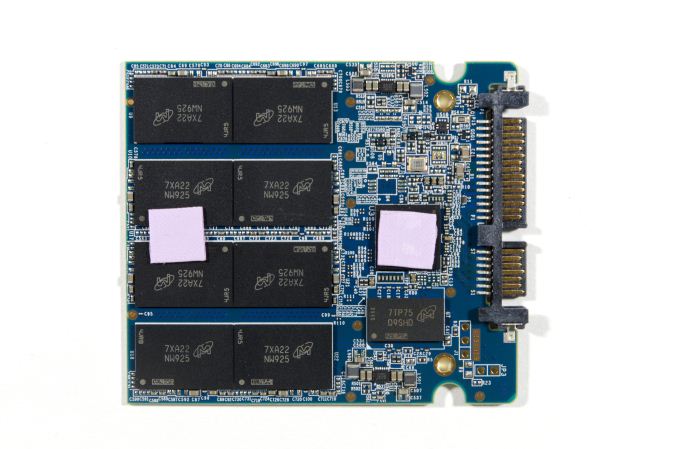The Crucial MX500 500GB SSD Review: A Second Look
by Billy Tallis on February 2, 2018 9:30 AM ESTConclusion
This second look at the Crucial MX500 reinforces our opinion of it as a solid performer, but it definitely isn't the fastest TLC SSD around. It is more common to find the MX500 placing second or third in its class on the performance tests, which isn't a problem if the price is right.
The 500GB MX500 is clearly slower than the 1TB model, and at first glance its performance relative to the competition is not as impressive as the results from the 1TB model. The 500GB capacity class is starting to become the default choice over smaller sizes, but it is no longer big enough to offer full performance even on drives that are limited by the SATA interface. On the other hand, the per-die capacity of the MX500's 64-layer 3D TLC is actually lower than that of the 32L 3D TLC used by the MX300, so the 250GB model shouldn't be as handicapped as the smallest MX300 was.
Since our first look at the Crucial MX500, the Samsung 860 PRO has raised the bar again for SATA SSDs. However, it exists in a price bracket that has been taken over by NVMe SSDs, so it isn't really serious competition for mainstream SATA drives. It is the TLC-based 860 EVO that will really matter. Samsung has clearly refined both their controller and their NAND, and we expect the 860 EVO to improve over the 850 EVO in both performance and power consumption.
When the dust settles on this round of product launches, Crucial will probably once again be in the position of offering a slower but cheaper option than Samsung's mainstream SATA drive. But this time around, the performance gap will be much smaller, and the MX500 comes with far fewer caveats than the MX300. The MX500 doesn't have serious performance problems when full like the MX300 and many other entry-level SSDs. The warranty and write endurance ratings are decent, and the MX series still matches Samsung's SSDs for features like drive encryption.
| SATA SSD Price Comparison | ||||
| 240-275GB | 480-525GB | 960-1050GB | 2TB | |
| Crucial MX500 | $79.99 (32¢/GB) | $134.95 (27¢/GB) | $259.99 (26¢/GB) | $499.99 (25¢/GB) |
| Crucial BX300 | $87.99 (37¢/GB) | $144.99 (30¢/GB) | ||
| Crucial MX300 | $92.99 (34¢/GB) | $147.45 (28¢/GB) | $274.99 (26¢/GB) | $546.23 (27¢/GB) |
| Samsung 850 EVO | $99.99 (40¢/GB) | $149.99 (30¢/GB) | $299.99 (30¢/GB) | $696.00 (35¢/GB) |
| Samsung 860 EVO | $94.99 (38¢/GB) | $169.99 (34¢/GB) | $329.99 (33¢/GB) | $649.99 (32¢/GB) |
| SanDisk Ultra 3D | $79.99 (32¢/GB) | $139.99 (28¢/GB) | $249.99 (25¢/GB) | $549.99 (27¢/GB) |
| WD Blue 3D NAND | $79.99 (32¢/GB) | $139.96 (28¢/GB) | $259.99 (26¢/GB) | $529.99 (26¢/GB) |
| Samsung 850 PRO | $155.00 (61¢/GB) | $219.99 (43¢/GB) | $429.99 (42¢/GB) | $888.61 (43¢/GB) |
| Samsung 860 PRO | $139.99 (55¢/GB) | $249.99 (49¢/GB) | $479.99 (47¢/GB) | $949.99 (46¢/GB) |
| ADATA SU800 | $78.50 (31¢/GB) | $139.99 (27¢/GB) | ||
| Toshiba TR200 | $79.99 (33¢/GB) | |||
| Intel 545s | $89.99 (35¢/GB) | $149.99 (29¢/GB) | ||
Crucial and Samsung are both making quick transitions to their new models: the MX300 and the 850 series SSDs are starting to go out of stock and their prices are climbing. The full range of MX500 capacities are now mostly in stock, as are most of the Samsung 860 PROs and EVOs, and they're all still pretty much stuck at MSRP. Even at MSRP, the Crucial MX500 is priced to beat all the other SATA SSDs using 64L 3D NAND, and it more or less matches the older and slower models that are still available.
Other SSD manufacturers don't seem to have fully reacted yet to the Crucial MX500's pricing. The Western Digital WD Blue 3D/SanDisk Ultra 3D is almost as fast as the MX500 and almost as cheap, so it's a good product to keep an eye on, but not the one to buy if you're buying today (except at 1TB, where the Ultra 3D is $10 cheaper).
The Intel 545s uses similar NAND and controller to the MX500 but usually comes out slightly ahead. However, Intel hasn't been pricing the 545s very aggressively and they haven't released 1TB or 2TB capacities. Toshiba's DRAMless TR200 is barely a presence on the market with only the 240GB model in stock and at a price no cheaper than mainstream drives. The many other brands that don't manufacture their own NAND flash are using the 64L 3D NAND they can acquire for PCIe SSDs, so the rest of the competition for the MX500 is last-generation SATA drives.
The MX500 is one of the cheapest SSDs on the market at the moment, and it offers real-world performance very close to the Samsung 850 EVO. This makes it very easy to recommend.
The only caveat to that recommendation is that power efficiency has taken a step backwards with the MX500, while Samsung appears to be setting new records in that department with the 860 series. We expect our upcoming testing of the 860 EVO to show it using less power than the MX500 and probably offering slightly better performance. But at the moment it looks like those probable advantages come at a pretty steep premium.












25 Comments
View All Comments
jordanclock - Friday, February 2, 2018 - link
Generally, any good SATA SSD is going offer much the same performance as any other model. The gains when going from the second (or even fifth) best SSD on SATA to the absolute best are tiny. Plus, given the capacity you would want for a console, I think going for a 'mediocre' SSD will offer all the performance you need without spending twice as much for less than one second load time differences.leexgx - Tuesday, February 20, 2018 - link
this is true once you have a SSD (any) in a console your purely limited by the CPU speed and ram in the PS4 or xbox it self (some youtubers have tested it) even to the point the SSHD from seagate and toshiba after the second load is nearly the same as a SSD (but it has to have read the data before so if you load the same game or save twice for it work well witch mite happen if you die a lot and fall back to a checkpoint save) if you switch between games SSHDs can at times offer not as much benerfitstill can't beat SSDs for consistency as it always be the same speed
tamalero - Friday, February 2, 2018 - link
Those prices feel really nice!Hurr Durr - Sunday, February 4, 2018 - link
It's not nice until we hit around 10 cents for the gigabyte.zirk65 - Friday, February 2, 2018 - link
Looks similar to the MX200, but with bigger pipes and better thermals.MX200 = MLC NAND / Marvel Controller
MX500 = TLC NAND / Silicon Motion Controller
Yet I wonder much is different between the controller uArch these days, outside of specific I/O and power functions.
mode_13h - Friday, February 2, 2018 - link
Last I checked, Crucial's MX-series SSDs featured end-to-end data protection. Does Samsung offer anything like that, in their consumer drives?letmepicyou - Friday, February 2, 2018 - link
Say Mr. Tallis, I'm sure I'm not alone when I ask this (feel free to chime in, guys) but there are those of us out here who want the greater capacity of a 1tb drive whilst not wanting to fork over 1tb drive prices. I can RAID 0 a pair of ~500gb drives and get better performance than a single 1tb drive, while spending $60-$120 less.What I'm saying is, I would love to see how your arsenal of ~500 gb drives perform in RAID. I have a feeling others would like to see the same information.
Billy Tallis - Friday, February 2, 2018 - link
You can't get a pair of 500GB drives for $60 less than the price of a 1TB drive from the same product line, unless you're looking at an unusually good sale on the 500GB drives and not looking for the best price on a 1TB drive. Every 1TB SATA drive I price checked this week was cheaper per GB than its half-TB counterpart.As for RAID testing, my collection of drives almost never includes more than one of each. At the moment I'm finishing up a NVMe RAID review using a set of drives that was loaned by a vendor specifically for this review. Between the disappointing results I'm getting from that project and the prices I'm seeing that don't make SATA RAID economical either, it's not a priority for me to test SATA RAID.
Wardrop - Saturday, February 3, 2018 - link
Is that a software raid or hardware raid you used for your NVMe raid review. I'm guessing software as I'm not even sure any NVMe raid solutions exist. In that case, I imagine we're back to needing dedicated RAID controller to deal with the order of magnitude increase in drive performance compared to HDD's, and then obviously you're left questioning who needs double the increase in sequential performance when a single drive is usually more than fast enough for any sequential workload.peevee - Monday, February 5, 2018 - link
Check m.2 PCIe/NVMe 1TB and 2TB prices.But you'll need an MB with 2 M.2 slots with 4x PCIe connected to CPU, are those even available? Otherwise latencies will dominate the performance (like for M.2 which only provide SATA, either slots or drives).